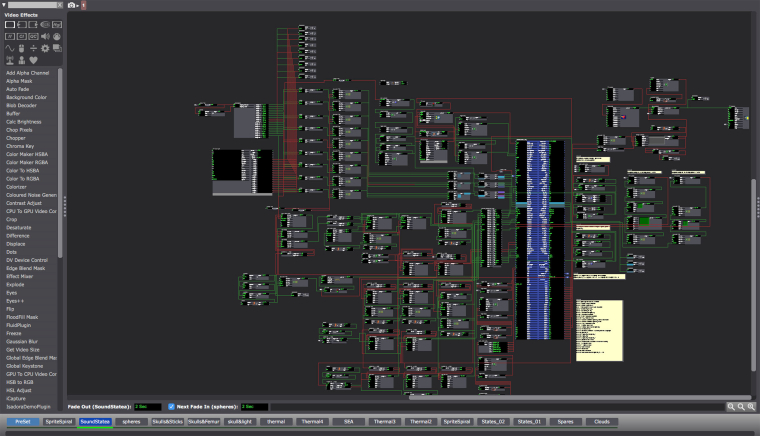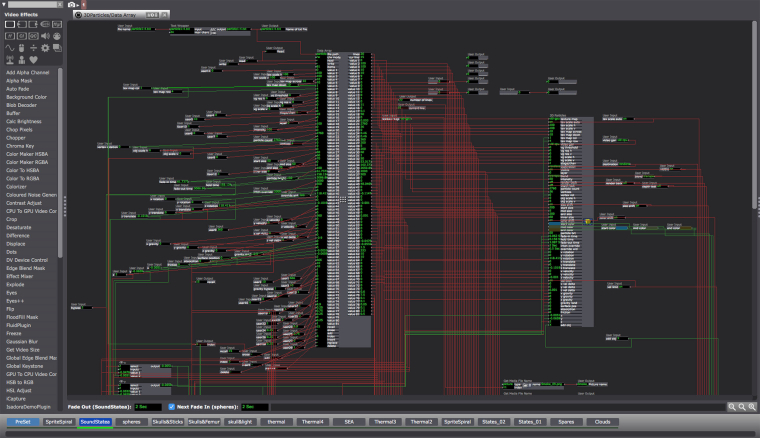Particle emitter parent and child?
-
Hi,
after attending Marks workshop in Berlin I feel quite confident with the particle emitter... and I start to wonder: Is there any chance to create a particle system with a parent emitter, that emits other emitters?
-
After using the '3d Particles' and '3D Model Particles' extensively I find they are very versatile and provide a lot of generative and responsive potential to real time graphics manipulation. I am, for whatever reason, drawn to real-time generative graphic production over pre-recorded video playback. Perhaps because all of the tools for realtime interaction and graphic iteration in Isadora are so ready for integration.
Over the last couple of years I have matched these generative actors in Isadora with audio frequency parameters when working with live musicians. However, after struggling with capturing and replicating generative effects, I have tried more and more elaborate pairings of the 'Data Array' and '3D Particles' embedded in user actors. I don't know if I am best placed to answer your question about parenting a particle emitter, although using the 'Data Array' method allows a matrix of different particle states to be 'called' interactively and enacted through the Particle actors.
Figure1 (below). Shows the DataArray/3D Particles 'user actor' in context of a scene in Isadora. It is surrounded by many other user actors and 'limit scale' actors that modify dynamic ranges updating the particle system in realtime in response to audio frequency data streams. These dynamic ranges are calibrated through parameters setup using the 'DataArray' actor embedded in the highlighted user actor indicated.

Figure 2 (below). Looking inside the DataArray/3D Particles user actor. A set of over 80 data points defines a matrix of different 3D Particle states that can be extracted interactively from the 3D Particles actor embedded in the user actor.

-
Hi bonemap, thanks for your quick response. That looks rather impressive. I have to admit, that I have not used the "data array actor" so much, so it might take me a while to understand your pics properly. Have you got any simple patch, I could look at? Best regards from Denmark ;O)
-
wow - what a patch! And I thought some of mine were complicated... wow.
-
The Data Array is a tricky actor to work with as it stores values in an external text file. It is extensible, which means you determine the number of data values in the matrix and the variables of each of the data values are stored in corresponding 'lines' in an external text file. If I specify 10 data values (these are referred to as 'items' in the data array actor), 10 delimited values are stored across one line in the text file and the line number is then used to call up a corresponding set of data values or 'items'. The text file can store a growing number of lines (sets of item values) and the data array actor can read and write the item values within these 'lines' to the text file. The way to edit the 'items' in the text file is to determine the values of a set of items and then record them using the actor inputs: recall, erase, add, insert, replace, delete. None of the functionality to write, store, retrieve and edit the data array sets (stored in 'lines') is intuitive and the layout of the actor adds additional hurdles in determining what is being written to the text file and in what line order - hence it is both a powerful and frustrating actor to work with. It is very easy to inadvertently overwrite a specific line of values because the 'index' input is set to the wrong line number. In addition input values that can be written to the text file do not visually align with current values being read - therefore I recommend the construction of a user actor so that some sense can be made of data writing to the text file and data being read from the same text file and exactly where lines are being inserted or replaced. Initially, I worked with the data sets as lines in the text file itself as it was easier to access, copy and paste lines of values or tweak values in the text file, rather than wrangle the read and write functionality of the data array actor itself. A good starting point is the Isadora manual.